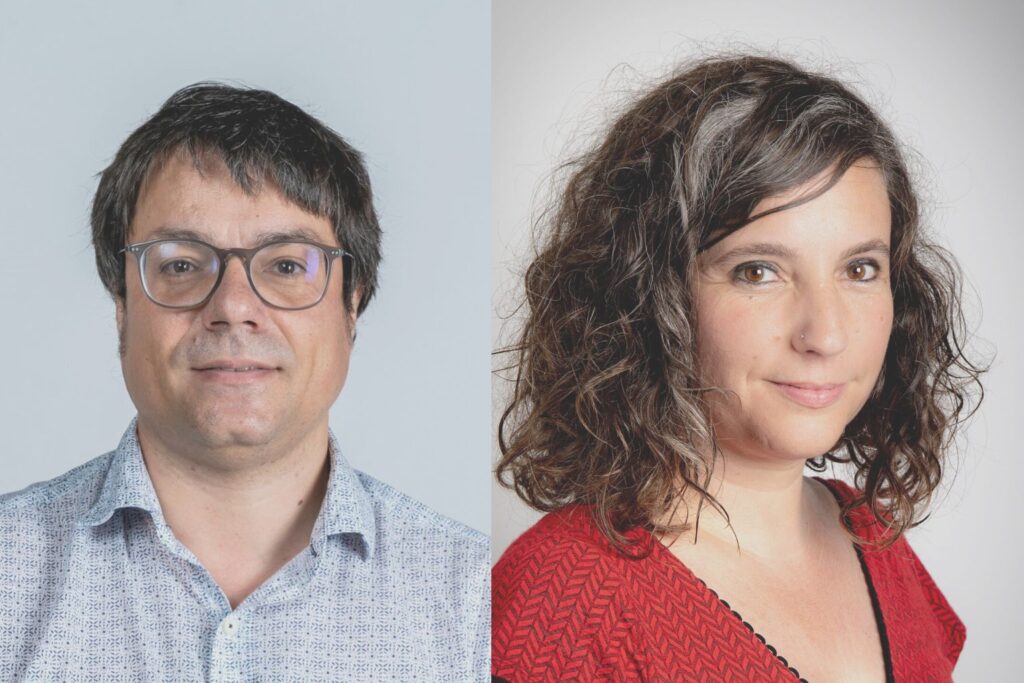
Rotterdam’s Stadmakerscongres aims to bring innovative minds together to explore new ways to address the current challenges cities face. AIR interviewed Xavier Matilla and Sílvia Casorrán, about their experiences helping to facilitate the transformation of Barcelona from a car-based grid model, with little available green public space, to one with an integrated resilience model combining urban greenery, public space, and mobility, using the “Superilla” (or Barcelona Superblock) model.
Xavier Matilla, architect-urban planner and Chief Architect of the Barcelona City Council, and Sílvia Casorrán, Mobility Councillor for Sant Martí District, and Deputy to the Chief Architect Office in Barcelona are this year’s Guest Urban Critics.
How can urban interventions like the Barcelona Superblock accelerate the energy transition, while making vibrant, green, and high quality spaces for people (not cars)?
“We imagine a Barcelona where the short distances are possible, but also at all sorts of scales, like the metropolitan one, or the global one. We’re not thinking of micro areas, with small transformations, but rather open areas with systemic transformation, allowing us to connect everything.”
– Xavier Matilla, Chief Architect of Barcelona
Introduction
Can you first take a moment to introduce yourselves and tell us a bit about your respective roles as Chief Architect, and the Deputy to the Chief Architect Office in Barcelona, and what your ambitions are for the city? What has your role been in implementing superblocks in the city?
X: I’m Xavi Matilla, I’ve been the Chief Architect of Barcelona since October 2019, so for three years, more or less. This moment is very exciting. I would say it’s an exciting moment for all cities around the world, but specifically Barcelona. Barcelona is undergoing a very important transformation process in order to face some critical challenges, from a social point of view, but also from an environmental one.
About the superblock program, it started in 2016, with the first experience in Poblenou, so when I arrived, the city council was finishing this. My role in this new stage was to work with the team, the specific team dedicated, defining what should be the new stage for the Superilla, so trying to think how we could unfold this first experience of the superblock, in order to define how it can contribute to solving global, city, and neighbourhood challenges. My main role has been to lead, and help in this new stage for the whole city of Barcelona, so we present Superblock Barcelona as a concept for our city.
S: I’m not an architect, I’m an environmental scientist, but I’ve always been working with urban planning and mobility especially. I’ve been helping Xavi’s team for the last 1,5 years. But for the last 5 years, I was responsible for cycling policies in the Barcelona metropolitan area. I’ve been involved with superblocks since 2015. At that point, I was working as technical support for the Barcelona City Council, because the mobility plan was already defining superblocks as a concept and the architectural team started to work on participatory processes. I was helping them with technical assistance, especially with mobility issues.
That was 2015, and in 2016, as Xavi said, the superblock began with a pilot, with implementing actions. As it happens, the starting point was where I live. I got very much involved, defending the project as a neighbour, because it began in a top down initiative, because it was a pilot, but then the municipality said: “okay, this is a pilot, but this is what we want to do, so why don’t we keep it?”
Then, the participatory process began with the neighbourhood helping to decide what to do with the new public space. It was top-down in the beginning, for the university’s pilot, but then the neighbours were able to define the new uses and furniture.
This was quite tricky, as there was some objection because it was made with tactical urbanism and just over one weekend. Neighbours expected things to return to what they were. But our Deputy Mayor, Janet Sanz, was really secure in the plan, she really wanted to go in this direction, and then she, along with the Sant Martí district, decided to keep it. My role between 2016 and 2019 then was more as an activist. This year, I’m in the municipality as deputy to Xavi’s team, helping with mobility issues related to public space. Public space and mobility have a lot to do with each other. Since 2019, I’ve also been the Mobility Counsellor in the district of Sant Martí, but that’s on my political side, not on my technical side. So, my relationship to superblocks has been very diverse, from many different angles.
The superblock concept
It’s interesting that you both stepped in at the moment when the pandemic set in, so you’re in positions of influence at a critical time in the city as you describe. It seems there have been two means of going about implementing it in the city, both the top down approach and the bottom up approach, and could you describe a little about what the process is ideally?
X: First, it’s important to explain the concept beyond the superblock, because there is a bigger concept, and there is another social level. You need to work with the technical complexities of the city before you can bring the project to the people. The idea behind the superblock is the organization of mobility, giving priority to public transport, biking, and walking, and trying to define a new urban mobility; one that’s healthier, and more efficient. In this hierarchy, mobility requires less public space.
We have a big problem in Barcelona. More than 60% of public space in the city is occupied by cars. We need to recover public space – the space now occupied by cars – and give this over to another kind of social activity. So the idea is to create a more efficient increase in urban greenery, and accommodate more social activities. To do this, we need to first identify the new mobility scheme for the city, then understand which places we can transform. So as I said before, this is a very technical issue, but also collaborative. It’s true that the experience in Poblenou, like Sílvia said, was probably too fast to define a technical solution for everything. But the experience was very important in order to define a new participatory process that has been able to change the social perception from a crisis position to a position where we’re receiving proposals for areas all around the city, demanding new superblocks in all neighbourhoods.
The city council has made a shift from a technical, top down condition, to another one that tries to bring these two conditions together
How much do the individual neighbourhoods’ qualities and characteristics come into play in terms of the kind of superblock that you conceive of in that particular area. You begin the task with the mobility challenge, but how do you consider impacts that the superblock can have on other aspects of the quality of life in that particular neighbourhood, for example, the kinds of amenities that are available, other socio-economic impacts beyond mobility?
S: In Barcelona of course, there are two different kinds of places that make the superblock concept different. One is the old town, and the other one is the “Eixample” grid from150 years ago, with the Cerdà Plan. When we go to the old town, it’s clear what the main road is, and where the traffic can go. In the end, thinking about mobility is thinking about where the public transit and the private traffic can pass through. So in the medieval areas, it’s quite easy, but when we go to the Eixample grid, all these streets that are 20 meters, they are all the same, you really have to insert a hierarchy in an artificial way. This is the work that Xavi’s team has been doing: defining these new green corridors, and defining which streets must be for people depending on where the schools are located, where the hospitals are located, what green areas we want to connect for people. This was more like a theoretical exercise, because you define with all of these ingredients, at least one of each of the three streets is a green corridor for people, and then when you place superblocks next to each other you have green corridors that connect on a larger scale.
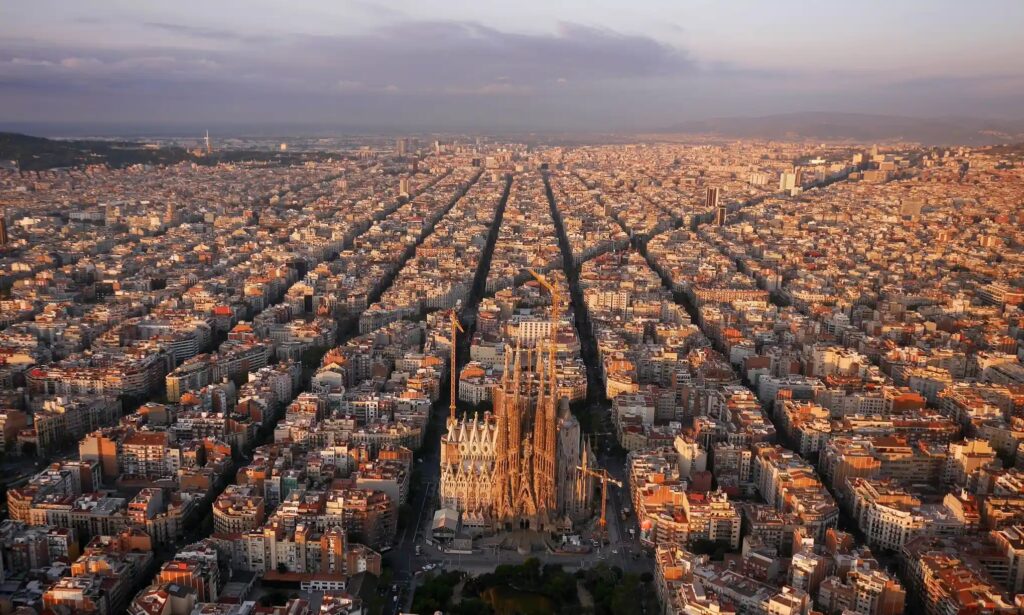
X: The idea was to shift from a first stage, where the experience of the superblock was for small sized areas, to another idea that challenges the concept of a green oasis in the middle of the urban fabric. The idea is to improve the whole city, not just a piece of it. This is where the concept for the green axis comes in, which is to visualize the same idea, and to build a new environmental infrastructure in the city as a whole. It’s important to note that Barcelona is a city with a very high density level, probably among the highest in all of Europe. We also have a high density of cars. We have roughly 6000 cars / km2. This is a considerably high number, and we don’t have large parks in the city – we have medium sized parks. We have the coast, but it’s not a green area. You could say Barcelona is basically a city of streets, so if you want to improve green areas in the city, we have to transform the streets, and this is what makes the Barcelona superblock so important, because it’s about how to transform the city with this as a foundational concept. The idea is to generate a green area that is less than 200m from every home (this is one of our goals), and to connect this with a framework of systems – such as enhancing biodiversity – in the city. It’s a systemic transformation. This is not just a transformation of different spots in the city, but a total system transformation.
S: The lack of green space in Barcelona is very clear, and when we compare it to the World Health Organisation’s ratings, in Eixample, for example, we’ve got 2 m2 / inhabitant. WHO says we need between 10-15, so the scarcity of greenery is very clear. With these green corridors, we see this as creating green infrastructure in the streets, not only in parks, because also inside the blocks it’s possible. Cerda planned it this way, but we lost it, and it’s very expensive for the municipality to buy back all these spaces that have been urbanized, or that are now private. We’re also working with this, and we’re getting something like 50 inside blocks that are green, but we need a lot more green in Barcelona and that’s why this project is so important. It’s not only about mobility and public space, but also about green.
The Superblock tool kit
So, two main components are the mobility network and the green network (neighbourhood). These are two tools in the superblock tool kit. What else does a superblock need?
X: I would say it must provoke a new approach to contemporary public space. At the moment, everything is designed around the car. So all urban furniture, the benches and so on, are designed to receive car impact. Materials are very durable. You could say that we don’t have a human scale of public space in our cities right now. As we are able to define a new mobility without cars, we have a new opportunity to rethink everything in public space: what materials we use, the furniture, the design that gives priority to different profiles in our society, like the elderly and children. We have a great opportunity to rethink public space for people. It’s not only important to remove cars from public space, but to redefine the conditions. This is one.
The other one is climate change, and how the street is able to incorporate environmental infrastructure in order to improve water cycle management, and moderate temperature. We need to understand the street as a three dimensional space, with the underground, the surface, and the air, and the role these different elements play in making a more resilient Barcelona that can withstand the effects of climate change. We need to redefine, and innovate the materials, and the social processes for the design of this new space, and this means defining a new environmental condition. It’s not only about uses, it’s also about how these spaces make Barcelona a better city environmentally.
S: For example, we are also trying to use permeable paving, and this is also key in this transformation – the resilience of the materials.
X: The current stage is this one, we realised a general structure of green axes connecting the different neighbourhoods of the city.
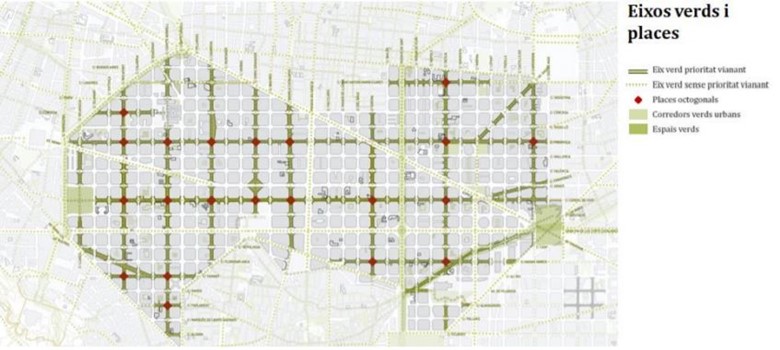
X: We have identified the Eixample as a priority area in the city due to its high levels of pollution, so we defined 21 new green axes within it. This means that each of these streets will be a green axis in the coming years, and we are able to transform crossing areas to create new public squares.

X: We are expecting to have these eight first projects completed at the beginning of 2023, so within the next year.
The 21st century plan
Another interesting image is this one that illustrates the concept for the 21st century street that we launched through a competition. This is the concept of the three-dimensional superblock’s five principles to pursue in the new design: new environmental infrastructure, promoting proximity (redefining this space for the elderly and young children), how we introduce new materials, and the big question in Barcelona of course, which is heritage preservation and landscaping. These are already permanent features, and we need to maintain them. Of course we also need to manage some kind of accessibility in order to maintain urban services, and provide access for different cars and vehicles to enable urban goods distribution.Are you working with the private sector to make this possible?
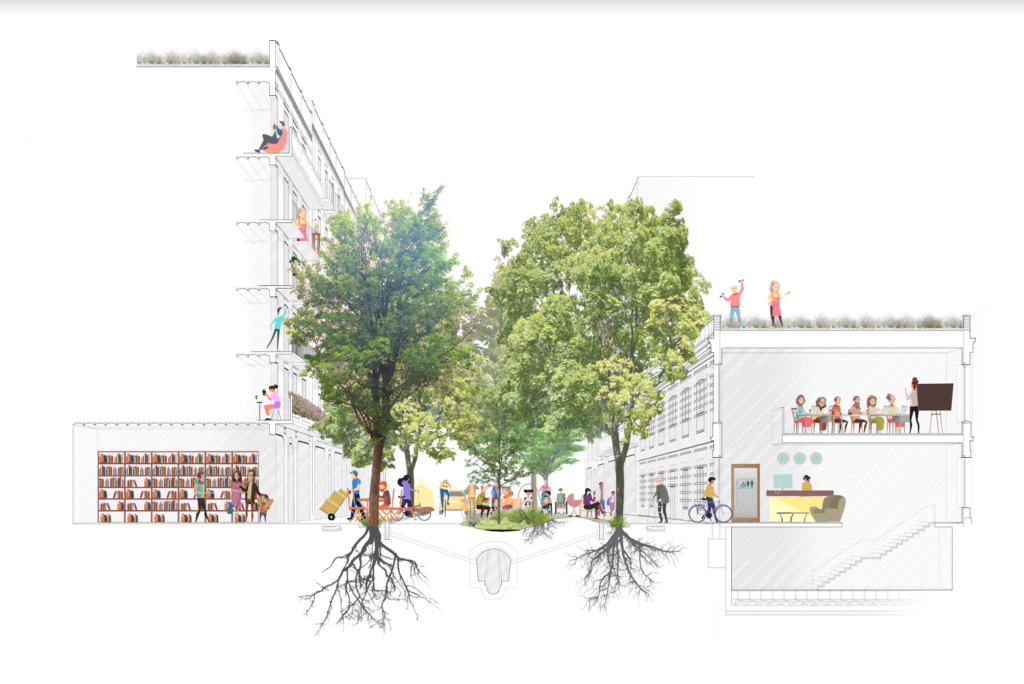
X: Basically, most intensely with retail associations, to incorporate urban goods transportation, and pursuing ways that we can improve connections between the private realm, and the public realm. This is a very important question in what has become known as the Barcelona model – this relationship between the private and public space.
A: Is your ideal a city that is a series of superblocks? Is this the 21st century plan?
X: We understand that the entire city of Barcelona must be a superblock. It’s not a composition of different small areas, it’s more interesting from an urban and social point of view to understand that everything is connected. We imagine a Barcelona where the short distances, like the 15 minute city, are possible, but also at all sorts of scales, like the metropolitan one, or the global one. We’re not thinking of micro areas, with small transformations, but rather open areas with systemic transformation, allowing us to connect everything.
A: Do you anticipate there being political push back (as there has been with some of the earlier projects)? Or are citizens now convinced of the need for public space in Barcelona especially as a result of the pandemic?
S: I think one of the problems with the first superblocks were the tactical urbanism actions. The actions against it had more to do with the rapid changes. It was more a rejection of tactical measures, than of the idea. Of course it was also the concept of the private car’s right to drive, and the superblock impedes this. Many neighbourhoods are asking for superblocks, as they understand what is possible, through the participatory budgets for example. In these green corridors that we’re proposing, we will not have tactical urbanism, and the designs will be really complete structural urbanism with ‘proper’ greenery, not just in pots. When you make this big transformation, no one will complain.
X: I think currently, nobody’s complaining about the superblock, because we’ve got to get cars off the street, and reduce air pollution. There is some objection to the ways that we’re trying to do these things, or the final result. I think it’s understandable because, in fact, the superblock attempts to change a cultural condition in the way we live in our cities, changing our behaviours and our urban lifestyle. It’s understandable that there are some doubts. In Barcelona, another challenge is the high quality of urban design that citizens expect, comes into conflict with some tactical urbanism strategies, which are not of such high quality. We’re introducing a new tool (not so new because it was introduced many years ago), but in any case, we’re trying to understand how this new kind of urbanism fits in Barcelona, and how to manage the cultural change.
S: This is what we’ve got now in one of our future green corridors, an example of tactical urbanism, which has been really criticised because “it’s ugly”.

X: This tactical action was in fact very useful, because thanks to the pandemic, we took advantage of the situation on the roads to accelerate the transformation. With this kind of tactical urbanism, we could reduce car lanes, take them over, and anticipate the final transformation.
S: This is the same street and the same area.
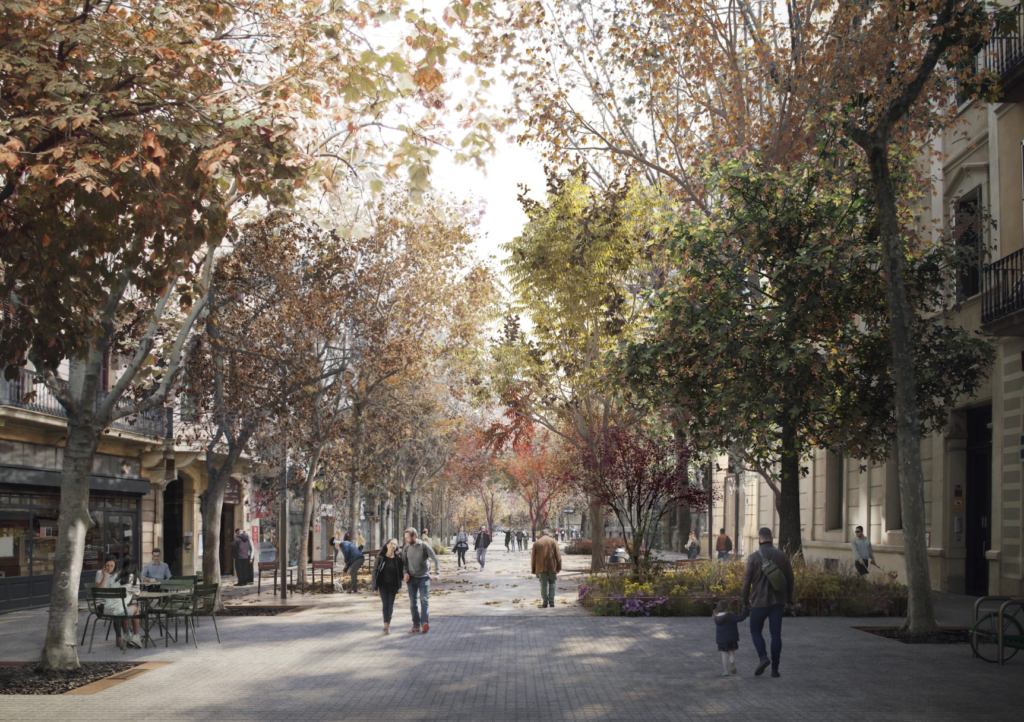
X: This will be next year.
S: No one will complain about this. They do about the tactical solutions, but not this.
Tactical urbanism
A: Do you see the tactical as nevertheless an essential part of the action of creating a superblock? As in, it’s iterative, first we take it over, and then the real development comes?
X: Yes, I used to say that if we want to make transformations, first we have to stop polluting, second, recover space, conquer the asphalt and this is where tactical actions make a lot of sense, and lastly introduce nature, but we also need to first need to conquer space. This is the difficult part of the process, because this really changes behaviours. This is the critical moment where we’re changing the conditions in public space. At this time, it’s very important to have low cost tools that are faster than the other ones to conquer space. It’s not the final one, but it’s a step toward a final transformation.
S: Because we have so many problems with noise, pollution, the climate emergency, and the lack of green space, we need to be really fast, and to transform this city, in this way, which is a total transformation, this will take us a long time. Next year, we will finish 5 km of the 180 that are planned for the green corridors, so if we really want to change the city, we need to invest in tactical urbanism, because it’s the way to change the existing public space in a faster way.
X: We need to manage going fast, and accommodate the speed of the city in this adaptation, while avoiding mobility collapse.
A: Finally, if you could boil the superblock down to its components, is it exportable? Can these kinds of changes be implemented in other settings? What do city architects and urban planners need to consider?
Sílvia: It’s totally exportable. The basic step to create superblocks is limiting private traffic access, and this can be done just by changing some street directions, obliging cars to turn while pedestrians and bikes can go through, and in each junction we can gain a new 2.000 m2 square. With the new car-free space, neighbours can decide what to do with it, so they will feel more attached to their territory. The crucial decision is about the temporality of the implementation. When we consider tactical actions, we must also take into account specific maintenance needs, so the greenery might be limited. But the superblock concept is so simple that it can be adapted everywhere!
In summary
Key phases of superblock implementation
- Stop polluting (by reducing the number of cars on the street)
- Recover space (by taking over space dedicated to cars)
- Introduce nature (by connecting public spaces, materials, and design, to natural systems)
Key components of a superblock
- Green spaces networked throughout the city using corridors
- Public mobility networks
- A new approach to contemporary public space design to introduce a more human scale
Profile
Xavi Matilla is an architect-urban planner graduated from ETSAV-UPC, born in Terrassa (Barcelona) in 1975. He has developed his professional career in different offices of recognized prestige in the field of urban planning, having won several awards and recognitions. He is also an associate professor at the Department of Urbanism and Spatial Planning (DUOT) at the Universitat Politècnica de Catalunya UPC_BarcelonaTECH and at the Master Metropoli in Metropolitan and Urban Studies, The Barcelona Institute of Regional and Metropolitan Studies (IERMB). He is currently the Chief Architect of Barcelona City Council.
Sílvia Casorrán (Barcelona, 1979) graduated in Environmental Sciences from Universidad Autónoma de Barcelona (2002). Part of her studies took place abroad in The Netherlands (Utrecht University, 2000) and in Mexico (Guadalajara University, 2001-2002). Her professional career has been developed in Sustainable Mobility planning and management, including 15 years as a consultant from private companies and for the last 5 years as public servant in Barcelona Metropolitan Area (AMB) and Barcelona City Council. In July 2019, she became the Mobility Councillor for Sant Martí District in Barcelona, and since March 2021, Deputy to Chief Architect Office in Barcelona City Council. She is a resident of the Poblenou Superblock, and a daily cyclist convinced about the potential of bikes in our cities and metropolis.
De Keynote lecture by Guest Urban Critcs Xavier Matilla and Sílvia Casorrán at the Stadmakerscongres 2022 will start at 4.30 PM at the Grote Zaal, Theater Zuidplein.